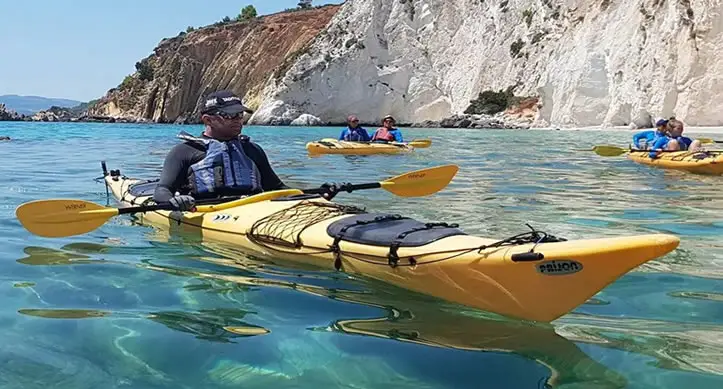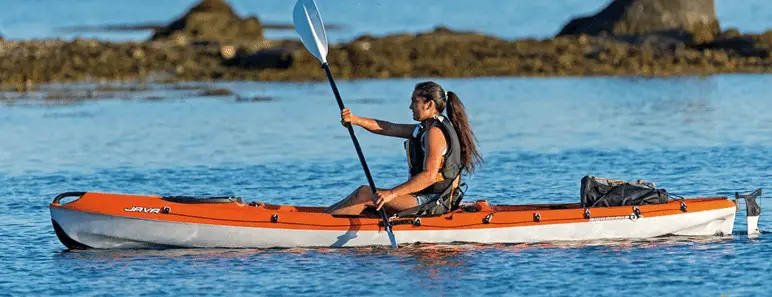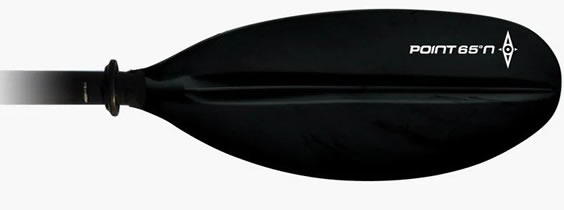Contents
- The Best Touring Kayaks And How They Are Used
- Design characteristics of a touring kayak
- The Many Uses Of A Touring Sea Kayak
- Recap: The Best Touring Kayaks & How They Are Used
The Best Touring Kayaks And How They Are Used
Let’s start off by exploring the basics of this unique boat. We can do that by posing the question, what is a touring kayak?
A touring kayak is a small personal watercraft that is propelled by a double-bladed paddle.
Also known as a sea kayak this type of vessel is perfect for long-distance paddling and long duration touring.
Touring kayaks differ in design to other more common kayaks.

The unique hull design of touring kayaks means they have long sleek bodies.
This long body makes a touring kayak ideal for use in both calm and rough water.
Its utilitarian design gives it perfect functionality for long distance paddling.
Touring kayaks are designed with built-in hatches for storing gear making them perfect for touring.
Be aware that some kayaks are marketed for sea and touring use but they are not true touring kayaks.
Below I explain what a true touring kayak is and how it differs from other, mismarketed, kayaks.
Design characteristics of a touring kayak
Although looking at a touring kayak you can tell immediately what type of boat it is (a kayak), touring kayaks have some fundamental design differences from other more common types of kayak.
Below I briefly describe how these boats differ from their close cousins.
The best touring kayaks come in 2 forms
Before we outline exactly what a touring kayak is.
It is a good idea to let you know that modern marketing techniques mean that most manufacturers and sellers will promote kayaks as touring boats when they are not.
We will show you a very common example of this as progress through this article.
Many people new to paddling find it difficult to identify exactly what a touring kayak is. This is because so many different types of kayaks are marketed as being good for ocean-use and touring.
Although many kayaks can be used in the ocean and for touring this type of marketing is misleading at best, and downright erroneous at worst.
There are typically 2 types of kayak that are promoted as touring, or sea, kayaks.
Both these types are marketed as touring kayaks but in truth only one of them really deserves the title.
The 2 types of kayak sold as touring kayaks are:
1. The sit on top touring kayak, (a.k.a. SOT kayak) which is capable of short touring but in truth not actually a touring kayak though it is often marketed as such.
2. The sit in touring kayak, (a.k.a. the closed cockpit, kayak). In truth this is the only true touring kayak as it is capable of handling almost all types of water and weather conditions and is designed to hold gear and provisions in watertight compartments.
Both kayak types can be used for long-distance and long-duration water excursions, from long-weekend fishing trips to boat camping adventures (see our guide to boat camping here).
But, because each kayak has its strengths and weakness you will see why the sit in kayak is the only true touring kayak capable of long-distance and long-duration use.
Sit on top touring kayak – the pseudo touring kayak
A sit on top kayak is the less popular choice for touring and sea use, for reasons we will cover below.
However, there are many different sit on top touring kayaks available on the market and they do have some distinct advantages over an enclosed cockpit kayak which we will also cover here.
A sit on top touring kayak, or commonly referred to as SOT, is a popular type of small vessel that is used by many paddlers on calm inland waters.
The main advantage of this kayak is its ease of use.
The paddler can just hop in and start paddling when seated atop the boat.

This kayak, like all kayaks, has a good reputation among many users due to its distinct characteristics and ease of use.
With a little practice, this type of kayak can be easily climbed back onto in case of unexpected dismount or a capsize.
Sit on top kayaks are also the preferred type for fishing because the open deck offers easy access to bait and catch and the raised seat allows for easier casting-off.
Manufacturers of sit on top touring kayaks offer a wide variety of styles and sizes depending on the user’s preference for comfort, size, ability, and paddling style.
Sit on top touring kayaks can come in the form of a two-seat or even a three-seat style, which is beneficial for couple or family use.
The main disadvantages of this kayak are that paddlers can be easily exposed to elements when out in the water and if conditions grow bad the boat will take on water and may even sink.
So, although some sit on top kayaks will be marketed as touring kayaks they are not suitable for long-distance and long-duration trips.
The only time you can use this type of kayak for touring is when you know the weather and water conditions will be optimal and stable throughout.
A sit on top touring kayak is better for fishing than long-duration trips but will struggle in challenging conditions and may even sink in very bad weather out at sea.
Make no mistake, SOT kayaks are capable of some open ocean trips, but the paddler needs to keep in mind that the likelihood of getting wet is high and so is the likelihood of taking on water.
This type of kayak is also restricted by weather conditions.
Where a sit in sea/touring kayak can ride high waves and endure wind, rain and spray, a sit on top kayak will struggle or even sink!
Having said that, when it comes to ocean kayaking a much better choice is a sit in touring kayak.
Sit in touring kayak – the true touring kayak
A sit in touring kayak, also called a sea kayak, is longer than other types of kayaks and a lot faster.
It also offers water-tight storage compartments for gear and provisions.
This type of kayak is also capable of handling all types of marine environments and can easily ride in the roughest of weather conditions.
A sit in touring kayak is usually made form tough polyethylene, a material that is flexible, durable, and impact-resistant.

Sit in touring kayaks can be one person or two person boats.
Even the two person boats have closed cockpits for each paddler.
A sit in sea/touring kayak is the only true touring kayak.
A sit in, or closed cockpit, touring kayak offers a different experience for a paddler from a sit on top kayak and it is a lot more versatile.
In truth a sit in sea/touring kayak is the only kayak that is really suited to long-distance and ocean use.
The closed cockpit on this type of kayak gives the paddler a drier ride because their lower body is not exposed to the elements.
Although the cockpit protects the paddler’s lower body from water spray, wind and rain further protection can be added with the use of a deck skirt.
A deck skirt totally isolates the paddler’s lower body in the boat.
Another thing to note is that a sit in touring kayak is much longer than the sit on touring kayak and has watertight compartments for storage.
This can be beneficial for paddlers planning for long duration trips.
The paddler is seated in the cockpit inside the boat.
This means that the paddler’s lower body is not only protected against the elements but is connected to it.
When inside the kayak, the paddler’s lower body can generate more thrust because the legs and lower torso are essentially enclosed and connected to the kayak.
This setup also aids in maneuvering the boat.
A sea/touring sit in kayak can handle most marine environments from calm water to rapids.
Because this type of kayak can handle almost every type of marine environment, and every type of weather condition, they are perfect for touring.
They are especially good for touring over long periods when you may have to navigate different waters under different weather conditions.
The only disadvantage of a sit in touring kayak is the difficulty of getting in and out of it.
However, this is a characteristic of every sit in kayak.
Different paddles used with a touring kayak
Once you have decided upon the best type of touring kayak for your particular needs your choices have not yet ended.
There is also the paddle to consider.
Sea or tour kayaks require paddles that should be suitable for your adventure of choice.
There are three basic paddle choices, namely:
1. Greenland
2. European
3. European
The Greenland paddle is perfect for lakes & bays
Greenland paddles have narrow and round blades.
These paddles are more beneficial for touring in the lakes or bays.

They allow you to pull less water with every stroke, thus giving you a more laid-back time kayaking.
Greenland paddles can be an arm-span short, which is used for sliding strokes (giving the paddle alternately both to your arms).
In addition, you can last a day with your tour kayak with this paddle because you are not giving too much energy with each stroke.
It should be mentioned that Greenland paddles can be packed as back up or support blades in open water explorations and overnight trips.
The European paddle offers more power & maneuverability
In contrast, European paddles or Euro blades are spoon-shaped in appearance.
The spoon shape of this paddle allows the paddler to gather more water and generate more power with each stroke.
This style of paddle is purposely made for accelerated paddling and to execute abrupt maneuvers.

Open water kayaking is a common type of water activities associated with Euro blades.
This type of paddle requires strong construction materials, like carbon-fiber.
Alternatively, manufacturers will also use hard wood, reinforced plastic or even aluminum.
European paddles are also easily recognizable because of its feathered shape.
This shape is applied to give the paddler ergonomic efficiency in open waters.
Best used for ocean exploration and multi-day trip kayaking because of its power and efficiency, the Euro paddle is a top choice for advanced kayakers.
The Wing paddle generates more thrust & speed
The third basic paddle type is the wing blade.
Named because it is shaped like a wing, this blade offers lift for the kayak as it slices through the water.
Imagine a set of airplane wings slicing through the air.
With wing paddles, more efficiency and better ergonomics are generated, thus giving the kayak greater thrust and acceleration.

This type of paddle is best used in kayaking tours that demand faster travel such as ocean exploration that usually result in greater distance covered than inland water kayaking.
Be aware that kayaking in the ocean requires specific skills and careful preparation as we covered in the article how to kayak in the ocean.
The next time you hit the water, keep in mind the 3 different paddle types and choose the one that is the right paddle for your tour kayaking needs and your level of experience.
Uses of a touring kayak
All types of kayaking offer excellent ways of touring which walking, cycling or hiking simply cannot provide.
Obviously, kayaking is done on the water which is another advantage over other touring methods.
This form of adventure takes people closer to the appreciation of marine biodiversity.
To be more specific, a touring kayak can be used in the following water-based nature activities:
1. Paddling on inland waters
2. Ocean exploration
3. Overnight or multi-day trips
Touring kayaks are much longer than other kayaks
Touring kayaks are longer than other types of kayaks with different lengths available.
For beginners, a shorter (usually 10-18 feet) and wider kayak is more advisable for its maneuverability and stability.
For experienced paddlers who want more speed and increased storage capacity, a long (up to 26 feet) and sharper kayak is more beneficial due to its superior efficiency and speed.
Most touring kayaks are longer for these reasons.
A sit in sea/touring kayak should be the first choice for adventure-seekers looking to go long distances such as open water touring and multi-day kayaking require.
Depending on which type of tour you choose, both types of touring kayak offer excellent performance.
The Many Uses Of A Touring Sea Kayak
Touring kayaks are not just reserved for ocean use.
A sea kayak is the perfect day touring kayak for inland waterway use
If a laid-back outdoor adventure is your approach, kayaking on a lake or a bay area is the way to go.
The unique design and utility value of this type of vessel makes it the ideal day touring kayak.
Lake kayaking allow you to get closer to the flora and fauna of inland waters.

You will also not be spending as much effort that the more adventurous ocean kayaking demands.
You can also go on boat camping trips.
Tour kayaking on inland waters also gives you flexibility when you want to cut your adventure short as you are closer to the land.
Diverse paddling techniques are also required.
The paddler will be forced to use strokes such as back stroke, low brace, high brace, forward sweep and even back sweep to steer the kayak along the bumpy waters.
You may want to read our article that demonstrates how to paddle against the current.
Ocean exploration can only be done safely in a touring kayak
Because touring kayaks are often used in the open ocean that are often referred to as sea kayaks.
Ocean exploration, or open water kayaking, requires a more complex approach to kayaking. You must plan the trip carefully. You will also need to bring necessary equipment for the trip like camping gears that can accommodate your touring needs for days.
With this activity, you are more exposed to open water wildlife, giving you opportunities to watch and study them.
Ocean exploration kayaking is commonly experienced by people who have already acquired intermediate knowledge and skills in paddling a kayak.
If you are new to ocean kayaking, or are interested in trying it out, then you will find our sea kayaking for beginners article every useful.
A touring kayaks are better for overnight or long duration trips
Multi-day or overnight trips using tour kayaks are another excellent way to spend your time on the water.
As more easy-to-carry camping kits and lightweight kayaking equipment become available, overnight and multi-day tours have become easier.
Most kayaks have built-in compartments, called hatches, used for carrying items that a paddler brings for a day tour and even multi-day trips.
Tour kayaks offer plenty of space and storage within their hatches so a paddler can carry necessary equipment for the trip.
Definitely, more days on the water demand for a bigger tour kayak that has more storage capacity.
Recap: The Best Touring Kayaks & How They Are Used
A touring kayak is a water vessel made from a strong material like Polyethylene.
A sit in sea kayak is the perfect choice for touring over long distances and/or over long duration periods due to its perceived unsinkability, durability, practicality and storage.
There are two types of touring kayak:
- A sit on top kayak
- The more popular and more versatile, sit in touring kayak.
If you need a guide to help you choice between these two types read our article Sit In vs Sit On Kayak. A Guide to Picking the Best One For You.
This type of kayak can be used for:
- Paddling on inland waters,
- Ocean exploration.
- Overnight or multi-day trips
These adventure activities require suitable kayaks for the paddlers.
For the beginner and inland calm water paddling, a sit on top kayak is more beneficial as it is easy to climb into.
For open water explorations and multi-day trips, a better-build kayak is favorable.
This is where sit in kayaks come into play.
By using a sit in touring kayak the paddler is more protected against the elements and water spray, especially if they use a deck skirt for added protection.
The kayaker should also consider which is the best paddle to use for their particular tour kayaking activities.
Wing and Euro paddles are great for long-distance and multi-day tours because they offer more power, speed and efficiency.
Greenland paddles give a more laid-back experience for relaxed touring like inland water kayaking.
This is due to the paddles’ character of not gathering too much water, thus generating low stroking force.

